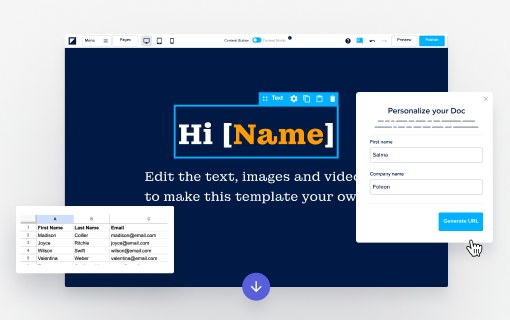Embarking on a marketing strategy where you hone in on the most lucrative accounts within your target audience is more than just logical—it's the secret sauce to unlocking unparalleled success. Prioritizing marketing and sales efforts towards high-value clients not only maximizes the impact of your budget but also aligns with the idea of delivering substantial value to those most likely to appreciate your brand.
However, this seemingly ideal scenario can remain elusive if you're not acquainted with the advantages of account-based marketing (ABM). Today, we'll delve into the concept of ABM, explore its advantages, and discuss actionable tactics to create compelling content for your ABM strategy.
What is account-based marketing?
Account-based marketing (ABM) is a unique marketing strategy that prioritizes your sales and marketing resources to focus on a set of high-value, high-likelihood target accounts within your market.
Rather than spending your marketing and sales money and energy on a range of accounts for your B2B marketing strategy, with ABM, you’ll focus those same resources on a smaller number of highly profitable accounts that align with your ideal customer profile (ICP). By doing this, you maximize the effectiveness of your marketing and sales tactics.
On top of that, account-based marketing typically emphasizes the personalization of MarTech. In this way, your marketing and sales teams can create highly relevant content tailored to the characteristics of each target account, creating a deeper connection with your audience at scale.
Discover: Why personalization matters in content marketing?
What are the benefits of account-based marketing?
There is a suite of benefits to account-based marketing that can truly transform your business. Many of which you’ll see an impact from almost immediately. These include:
- Higher ROI: ABM allows for a focused allocation of resources toward high-value accounts, leading to a more efficient use of budget and resources. This concentration on specific accounts increases the likelihood of conversion and a higher return on investment.
- Improved alignment between sales and marketing: ABM encourages collaboration between sales and marketing teams, ensuring a unified strategy. This alignment streamlines the sales process and improves the overall efficiency of both departments.
- Shorter sales cycles: ABM helps expedite the B2B buyer journey by concentrating efforts on critical accounts. Targeted and focused marketing efforts facilitate a more efficient progression of prospects through the B2B marketing funnel.
- Customer retention and growth: ABM is about acquiring new customers and nurturing and retaining existing ones. By focusing on specific accounts, ABM helps strengthen relationships with current clients, fostering loyalty and potential upsell opportunities.
- More precise measurement and analytics: ABM often provides a more precise and direct measurement of marketing success. Concentrating on target accounts makes attributing results to specific campaigns easier and adjusting inbound marketing strategies based on measurable data.
All in all, account-based marketing leads to better sales, efficiency, and results across the board.
Utilizing personalization in your ABM strategy
What is personalized marketing?
Marketing personalization involves a strategy that customizes content and engagements to cater to the specific needs of individual consumers. The focus is on treating each prospect as distinct, creating campaigns that align with their preferences and behaviors.
Why use personalization in your ABM strategy?
Personalization significantly increases the likelihood that your brand will break through the noise. The single most significant benefit of personalization is the ability to create highly targeted and relevant experiences for crucial accounts, allowing you to tailor your messaging to create customer-centric content unique to each target account's individual needs, preferences, and challenges. In a recent study of B2B technology buying decision makers, 45% of respondents said personalization makes them more comfortable with a brand.
Incorporating personalization into your ABM strategy can lead to the following:
- Improved customer experience: Clients are more likely to spend money on a particular company if they receive personalized marketing and sales experiences.
- Faster conversion rates: Personalization is shown to reduce sales cycles. Major purchase decisions in the B2B market typically involve negotiations and discussions with multiple stakeholders, often slowing sales. Personalized experiences in account-based marketing can help reduce your sales cycle by nurturing high-value prospects at scale.
- A clearer picture of your marketing ROI: Research from McKinsey shows that personalized marketing can reduce customer acquisition costs by as much as 50%. Because account-based marketing is so focused, it’s much more measurable and precise, enabling you to attribute revenue generated against marketing costs with far greater accuracy than other marketing strategies.
Start implementing personalization in your content with Foleon.
Other common account-based marketing tactics
Personalized email campaigns:
Develop highly personalized email campaigns tailored to crucial decision-makers within target accounts. Craft content that addresses their pain points, challenges, or needs. Use personalized subject lines, greetings, and content based on the account's profile and behavior.
Account-based advertising:
Implement targeted marketing collateral highly tailored to each target account. Company-specific targeting on LinkedIn can allow you to connect with potential influencers across multiple organizational departments and roles. Tailor the ad content to resonate with the account's characteristics and objectives.
Direct mail packages:
Send personalized and creative direct mail packages to crucial contacts within target accounts. This could include physical items like branded merchandise, personalized letters, or exclusive offers. The tangible nature of direct mail can make a lasting impression and differentiate your brand in a way that digital channels might not.
Maximizing effectiveness with common ABM tactics
To optimize your account-based marketing (ABM) approach, viewing each target account as a unique market with distinct needs requiring tailored solutions is crucial. Explore some widely utilized ABM tactics and strategies:
- Define your ideal customer profile (ICP): Understand your Ideal Customer Profile to identify and prioritize critical accounts. This allows you to position your services as an industry expert, tailoring your approach to the specific characteristics of each target account.
- Align marketing and sales: Ensure alignment between marketing and sales on the approach to target accounts. Develop industry-specific reports addressing challenges and offering solutions. Marketing creates highly targeted content, and sales distributes it to the target account, providing essential feedback loops for ABM campaign optimization. However, they must work together to fulfill the relevant KPIs for the campaign.
- Implement a multi-channel approach: Utilize a multi-channel approach to maintain visibility throughout the buyer journey. Ensure your brand remains front and center in the digital journey of target accounts, enhancing engagement and impact.
- Incorporate video marketing: Stand out by using video marketing messages and advertisements. Enlist critical figures, such as lead salespersons or the CEO, to create these videos. This personal touch can significantly enhance your message's effectiveness.
- Leverage user testimonials strategically: Develop and categorize them based on the expressed pain points. Tailor these testimonials to different target groups, ensuring they resonate directly with the concerns of each specific audience.
- Deploy personalized content: Utilize marketing emails, blog posts, and other text-based materials. While templates can streamline the content creation process, employ comparison and analysis tools to ensure each piece maintains a distinct and tailored approach. To simplify the process, start your ABM campaigns by prompting the whole team to brainstorm and contribute ideas in a document editor. With enough diverse perspectives, achieving personalizing will be much easier.
- Create prospect-specific offers: Develop offers tailored to each prospect, addressing identified pain points or providing additional value based on client insights. Special deals, discounts, or exclusive product offers can enhance your appeal and resonate with the unique needs of the target accounts.
- Implement marketing automation and CRM systems: No ABM strategy is complete without leveraging marketing automation tools and Customer Relationship Management (CRM) systems. These tools track engagement with target accounts at scale, allowing for efficient management and optimization of your ABM campaigns.
How to leverage content for account-based marketing
In the realm of account-based marketing (ABM), the role of content cannot be overstated. To foster a deeper connection, create compelling and personalized content experiences that speak directly to each account's unique needs, challenges, and interests.
Utilizing content creation platforms like Foleon allows the seamless creation of visually striking and interactive content experiences. This way, you’re empowered to craft content beyond the ordinary, delivering visually stunning interactive documents that can capture the attention of key decision-makers within your target accounts.
The platform also provides robust analytics features, allowing you to extract insights from your content. This data-driven approach empowers you to measure the engagement of your white papers or brochure, understand user behavior, and glean actionable insights that refine and optimize future ABM strategies.
Incorporating a solution like Foleon into your ABM strategy enables you to practice ABM more effectively and use data-driven intelligence for continuous improvement. Ready to experience the difference? Try Foleon today and witness its transformative impact on your content creation, delivery, and overall ABM success.
Psst... If you're curious to see how personalization can improve your content performance, then you should test Foleon.



